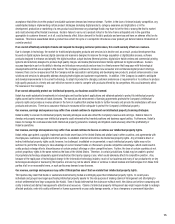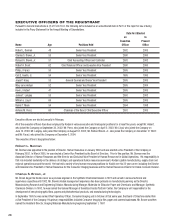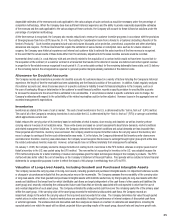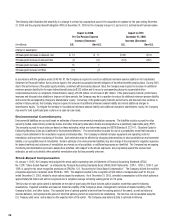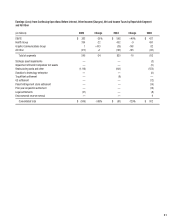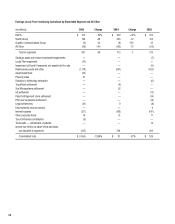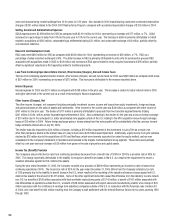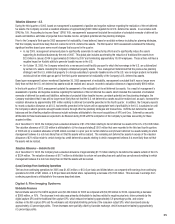Kodak 2005 Annual Report Download - page 27
Download and view the complete annual report
Please find page 27 of the 2005 Kodak annual report below. You can navigate through the pages in the report by either clicking on the pages listed below, or by using the keyword search tool below to find specific information within the annual report.25
dependable estimates of the revenues and costs applicable to the various stages of such contracts as would be necessary under the percentage of
completion methodology. When the Company does have suffi cient historical experience and the ability to provide reasonably dependable estimates
of the revenues and the costs applicable to the various stages of these contracts, the Company will account for these full service solutions under the
percentage of completion methodology.
At the time revenue is recognized, the Company also records reductions to revenue for customer incentive programs in accordance with the provisions
of Emerging Issues Task Force (EITF) Issue No. 01-09, “Accounting for Consideration Given from a Vendor to a Customer (Including a Reseller of the
Vendor’s Products).” Such incentive programs include cash and volume discounts, price protection, promotional, cooperative and other advertising
allowances and coupons. For those incentives that require the estimation of sales volumes or redemption rates, such as for volume rebates or
coupons, the Company uses historical experience and internal and customer data to estimate the sales incentive at the time revenue is recognized.
In the event that the actual results of these items differ from the estimates, adjustments to the sales incentive accruals would be recorded.
Incremental direct costs (i.e. costs that vary with and are directly related to the acquisition of a contract which would not have been incurred but for
the acquisition of the contract) of a customer contract in a transaction that results in the deferral of revenue are deferred and netted against revenue
in proportion to the related revenue recognized in each period if: (1) an enforceable contract for the remaining deliverable items exists; and (2) delivery
of the remaining items in the arrangement is expected to generate positive margins allowing realization of the deferred costs.
Allowance for Doubtful Accounts
The Company records and maintains a provision for doubtful accounts for customers based on a variety of factors including the Company’s historical
experience, the length of time the receivable has been outstanding and the fi nancial condition of the customer. In addition, Kodak regularly analyzes
its customer accounts and, when it becomes aware of a specifi c customer’s inability to meet its fi nancial obligations to the Company, such as in
the case of bankruptcy fi lings or deterioration in the customer’s overall fi nancial condition, records a specifi c provision for uncollectible accounts
to increase the allowance to the amount that is estimated to be uncollectible. If circumstances related to specifi c customers were to change, the
Company’s estimates with respect to the collectibility of the related receivables could be further adjusted. However, losses in the aggregate have not
exceeded management’s expectations.
Inventories
Inventories are stated at the lower of cost or market. The cost of most inventories in the U.S. is determined by the “last-in, fi rst-out” (LIFO) method.
The cost of all of the Company’s remaining inventories in and outside the U.S. is determined by the “fi rst-in, fi rst-out” (FIFO) or average cost method,
which approximates current cost.
Kodak reduces the carrying value of its inventory based on estimates of what is excess, slow-moving and obsolete, as well as inventory whose
carrying value is in excess of net realizable value. These write-downs are based on current assessments about future demands, market conditions
and related management initiatives. If, in the future, the Company determined that market conditions and actual demands are less favorable than
those projected and, therefore, inventory was overvalued, the Company would be required to further reduce the carrying value of the inventory and
record a charge to earnings at the time such determination was made. If, in the future, the Company determined that inventory write-downs were
overstated and, therefore, inventory was undervalued, the Company would recognize the increase to earnings through higher gross profi t at the time
the related undervalued inventory was sold. However, actual results have not differed materially from management’s estimates.
On January 1, 2006, the Company elected to change its method of costing its U.S. inventories to the FIFO method, whereas in all prior years most of
Kodak’s inventory in the U.S. was costed using the LIFO method. The new method of accounting for inventory in the U.S. was adopted because the
FIFO method will provide for a better matching of revenue and expenses given the rapid technological change in the Company’s products. The FIFO
method will also better refl ect the cost of inventory on the Company’s Statement of Financial Position. Prior periods will be restated in future fi nancial
statements for comparative purposes in order to refl ect the impact of this change in methodology from LIFO to FIFO.
Valuation of Long-Lived Assets, Including Goodwill and Purchased Intangible Assets
The Company reviews the carrying value of its long-lived assets, including goodwill and purchased intangible assets, for impairment whenever events
or changes in circumstances indicate that the carrying value may not be recoverable. The Company assesses the recoverability of the carrying value
of long-lived assets, other than goodwill and purchased intangible assets with indefi nite useful lives, by fi rst grouping its long-lived assets with other
assets and liabilities at the lowest level for which identifi able cash fl ows are largely independent of the cash fl ows of other assets and liabilities (the
asset group) and, secondly, estimating the undiscounted future cash fl ows that are directly associated with and expected to arise from the use of
and eventual disposition of such asset group. The Company estimates the undiscounted cash fl ows over the remaining useful life of the primary asset
within the asset group. If the carrying value of the asset group exceeds the estimated undiscounted cash fl ows, the Company records an
impairment charge to the extent the carrying value of the long-lived asset exceeds its fair value. The Company determines fair value through quoted
market prices in active markets or, if quoted market prices are unavailable, through the performance of internal analyses of discounted cash fl ows
or external appraisals. The undiscounted and discounted cash fl ow analyses are based on a number of estimates and assumptions, including the
expected period over which the asset will be utilized, projected future operating results of the asset group, discount rate and long-term growth rate.


